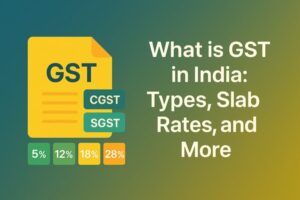The Evolution of GST Administration in India: What You Need to Know
- 10 Aug 24
- 21 mins

The Evolution of GST Administration in India: What You Need to Know
- The Evolution of GST in India
- The Goals Behind Implementing GST
- The Benefits of GST for the Economy and Businesses
- Breaking Down the Components of GST
- Taxation Before GST
- GST's Impact on Price Reduction and Inflation
- The Role of the Reserve Bank of India (RBI) in the GST Era
- How Banks Facilitate the GST Framework?
Key Takeaways
- GST unified India's complex tax system into a single, streamlined process, enhancing transparency and efficiency.
- The implementation of GST was the result of extensive planning and consensus-building among central and state governments.
- GST aimed to eliminate the cascading effect of taxes, create a unified national market, and simplify the tax structure for businesses.
- The Goods and Services Tax Network (GSTN) plays a crucial role as the technological backbone of the GST administration.
- GST has significantly impacted the economy and businesses by reducing tax burdens, encouraging compliance, and fostering a competitive market environment.
The Goods and Services Tax (GST) marks a major fiscal change in India's history. Starting on July 1, 2017, it consolidated various indirect taxes into one system, fundamentally altering the structure of taxation in India. This major change sought to simplify the taxation process and make it clearer, more efficient, and favorable for businesses.
The rollout of GST was the result of years of planning, negotiation, and agreement among all involved parties, including the central and state governments. It was seen as a means to remove the overlapping effect of taxes, create a unified national market, make business operations smoother, and increase adherence to tax regulations through the use of technology.
The Evolution of GST in India
The concept of GST was initially proposed in the year 2000 by the government under Prime Minister Atal Bihari Vajpayee. A committee was formed to draft the GST law, initiating India's move towards an inclusive indirect tax reform. The proposal sought to merge state economies and stimulate growth by establishing a single, integrated Indian market.
Legislative Steps and Challenges
In 2004, the Task Force on the Fiscal Responsibility and Budget Management Act suggested introducing GST to enhance the tax system. The Finance Minister, in his 2006 budget announcement, set April 1, 2010, as the target date for implementing GST. Nonetheless, due to political and economic hurdles, such as disputes over revenue distribution between the central and state governments, the rollout was postponed.
The Path to Implementation
The introduction of the Constitution (122nd Amendment) Bill in 2014 was a crucial step that prepared the foundation for GST. Following thorough discussions and agreement, the bill was approved by both Parliament houses in 2016 and was sanctioned by the President, turning into the 101st Constitutional Amendment Act. This amendment prepared for GST's launch in India.
Launch and Implementation
GST was officially launched on July 1, 2017, during a historic midnight session of Parliament. This new tax regime replaced several indirect taxes previously levied by the central and state governments, such as the Value Added Tax (VAT), Service Tax, Excise Duty, and others. The GST system was intended to be powered by technology, with the Goods and Services Tax Network (GSTN) acting as the central support for all digital GST compliance activities.
Below is a concise timeline highlighting the evolution of the Goods and Services Tax (GST) in India, presented in a tabular format:
| Year | Milestone |
|---|---|
| 2000 | The idea of GST is first introduced by the Atal Bihari Vajpayee government. A committee is set up to draft the GST law. |
| 2004 | The Task Force on Implementation of the Fiscal Responsibility and Budget Management Act, 2003, recommends GST to replace the existing tax structure. |
| 2006 | Finance Minister P. Chidambaram proposes GST's introduction from April 1, 2010, in his Budget speech. |
| 2008 | The Empowered Committee of State Finance Ministers (EC) releases its First Discussion Paper on GST in India, outlining the proposed GST model. |
| 2010 | The Constitution (115th Amendment) Bill is introduced in the Lok Sabha to enable the introduction of GST. |
| 2011 | The Constitution (115th Amendment) Bill, 2011, lapses due to the dissolution of the 15th Lok Sabha. |
| 2014 | The Constitution (122nd Amendment) Bill is reintroduced in the Lok Sabha by the new government. |
| 2016 | The Constitution (122nd Amendment) Bill is passed by both houses of Parliament and receives the President's assent, becoming the 101st Constitutional Amendment Act, 2016. |
| 2017 | GST is launched at midnight on July 1, 2017, during a special session of Parliament, marking the implementation of the unified tax system in India. |
| 2018-2023 | Various amendments and updates to GST laws and rates, including simplification of return filing, introduction of e-invoicing, and rate rationalization to address business and consumer concerns. |
Post-Implementation Adjustments
The initial phase of GST implementation came with its set of challenges, including technical glitches on the GSTN online portal, confusion over tax rates, and compliance burdens on small and medium enterprises. The government and the GST Council, comprising state finance ministers and chaired by the Union Finance Minister, have been proactive in addressing these issues. They have made several amendments to GST laws, simplified tax rates, and introduced measures like the composition scheme to ease the compliance burden on small businesses.
The Goals Behind Implementing GST
The Goods and Services Tax (GST) was introduced in India with several ambitious goals aimed at overhauling the country's complex tax structure. This landmark tax reform was not just about simplifying the taxation system but also about creating a more integrated, equitable, and efficient economic environment. Here are the primary objectives behind the implementation of GST:
1. To Eliminate the Cascading Effect of Taxes
One of the most critical goals of GST was to remove the cascading effect of taxes, or "tax on tax," prevalent under the previous tax regime. Before GST, the central and state taxes were levied separately, and the input tax credit was not available across the board, leading to a higher cost of goods and services. GST introduced a comprehensive input tax credit system, ensuring that taxes paid at each stage of the supply chain could be availed as a credit, reducing the overall tax burden and, consequently, the cost of goods and services.
2. To Create a Unified National Market
Prior to GST, the Indian market was fragmented along state lines, with each state having its own set of taxes and regulations. This fragmentation hindered the free flow of trade across the country, creating logistical inefficiencies and additional costs. GST aimed to unify the market by creating a single tax regime across India, facilitating smoother interstate movement of goods and services and bolstering the idea of "one nation, one tax."
3. To Simplify the Tax Structure
The pre-GST era was characterized by a complex array of indirect taxes, including VAT, service tax, excise, and others, each with its own rates and rules. This complexity made compliance burdensome for businesses, especially small and medium enterprises. GST sought to simplify this by consolidating multiple taxes into a single tax, streamlining tax administration, and making compliance easier and more transparent.
4. To Enhance Compliance and Reduce Tax Evasion
A major issue in the tax system before GST was the widespread tax evasion, due to the system's complexity and ineffective enforcement. GST was designed to improve compliance through a technology-driven approach, with the GSTN serving as the backbone for all transactions. This digital platform facilitates the tracking of transactions across the value chain, making it harder for evasion and ensuring a broader tax base.
5. To Boost Economic Growth

By eliminating economic obstacles and fostering a better environment for businesses, GST sought to encourage economic expansion. The hope was that a simpler tax system would promote investment and business growth, resulting in job creation, higher productivity, and increased GDP growth over time.
6. To Increase Government Revenues
A broader tax base combined with improved compliance was expected to increase government revenues. By simplifying the tax structure and making it more transparent, GST aimed to encourage more businesses to become compliant, thereby increasing tax collections both for the central and state governments.

7. To Improve the Efficiency of Logistics and Distribution
The removal of interstate check posts and the unification of the tax structure under GST have significantly improved the efficiency of logistics and distribution networks in India. This has not only reduced the delivery time of goods across states but also lowered the costs associated with warehousing and inventory management.
The Benefits of GST for the Economy and Businesses

The Goods and Services Tax (GST) has brought about significant benefits for both the Indian economy and the business community. By overhauling the country's tax structure, GST has aimed to foster a more efficient, transparent, and competitive economic environment. Here are some of the key benefits:
For the Economy:
- Unified Market: GST has transformed India into a unified market, eliminating interstate barriers and reducing the cost and complexity of doing business across state borders.
- Increased Tax Base: By simplifying the tax structure and making compliance easier, GST has encouraged more businesses to register and pay taxes, thereby widening the tax base.
- Boost to Foreign Investment: The simplified tax regime has made India a more attractive destination for foreign investors, who now face fewer complexities when looking to set up operations in the country.
- Enhanced Economic Efficiency: The elimination of the cascading effect of taxes and the improved logistics and supply chain efficiency under GST have contributed to reducing the production and distribution costs, making the economy more efficient.
- Higher Revenue Collection: Improved compliance and a broader tax base have led to increased revenue collections, providing the government with more resources to invest in public services and infrastructure.
For Businesses:
- Ease of Doing Business: GST has replaced multiple indirect taxes with a single tax, simplifying the tax paying process and reducing compliance burdens, especially for small and medium enterprises.
- Input Tax Credit: Businesses can now claim input tax credit across the supply chain, from procurement to the sale of goods and services, reducing the overall cost of inputs and increasing profitability.
- Improved Competitiveness: The reduction in the overall tax burden on goods and services has made Indian products and services more competitive in both domestic and international markets.
- Technology-Driven Compliance: The GSTN portal facilitates online procedures for tax payments, returns, and registrations, making the processes more transparent and efficient.
- Reduced Logistics Costs: The removal of interstate check posts and the unification of taxes have streamlined the movement of goods across states, significantly reducing logistics costs and delivery times.
Breaking Down the Components of GST
GST in India is structured around three main components, designed to address the taxation at both the central and state levels. This structure ensures that both the central and state governments have their share of revenues under the GST regime. The components are:
- Central Goods and Services Tax (CGST): This is the tax collected by the Central Government on intra-state sales (i.e., transactions and services within a single state). The revenue collected under CGST is for the central government.
- State Goods and Services Tax (SGST): Collected by the State Government, SGST applies to intra-state sales. The revenue from SGST goes to the state government where the transaction occurs.
- Integrated Goods and Services Tax (IGST): IGST is charged on inter-state transactions and imports. It ensures that the state destination principle is adhered to, with the tax revenue going to the state where the goods or services are consumed. IGST is shared between the central and state governments as per the rates decided.
This tripartite structure ensures a seamless flow of tax credits from the manufacturer to the end-consumer, thereby minimizing the cascading effect of taxes and making the entire system more efficient. By understanding these components, businesses can better navigate the GST landscape, ensuring compliance and optimizing their tax liabilities.
Taxation Before GST
Before the introduction of the Goods and Services Tax (GST) in India, the taxation landscape was characterized by a complex and fragmented system of multiple indirect taxes levied by both the central and state governments. This system not only made compliance cumbersome but also led to inefficiencies and added costs for businesses and consumers alike. Here's a brief overview of the pre-GST tax regime:
- Multiple Taxes: Businesses had to navigate a plethora of taxes, including Value Added Tax (VAT) levied by states, Central Excise Duty on the manufacture of goods, Service Tax on services, and additional customs duties on imports. Each of these taxes came with its own rules and rates, adding to the complexity.
- Cascading Effect: One of the most significant drawbacks of the pre-GST system was the cascading effect of taxes, where tax was levied on an already taxed value, leading to the tax-on-tax effect. This inefficiency inflated the costs of goods and services for the end consumer.
- Interstate Tax Barriers: Interstate commerce was subjected to Central Sales Tax (CST) and entry taxes, creating barriers to the free flow of goods across state borders. This not only complicated compliance but also hindered the creation of a unified national market.
- Compliance Burdens: The existence of multiple taxes under the jurisdiction of different tax authorities meant businesses had to comply with numerous filing processes, audits, and regulations, increasing the administrative burden and compliance costs.
- Limited Input Tax Credit: The pre-GST regime allowed limited input tax credit, which could not be availed across the spectrum of goods and services, further contributing to the cascading effect of taxes.
GST's Impact on Price Reduction and Inflation

The implementation of GST was aimed at addressing the inefficiencies of the previous tax system, with significant implications for prices and inflation:
- Reduction in Cascading Effect: By allowing the seamless flow of input tax credit across goods and services at both the central and state levels, GST has significantly reduced the cascading effect of taxes. This reduction in tax-on-tax has, in many cases, led to a decrease in the cost of goods and services, benefiting consumers.
- Rationalization of Tax Rates: GST introduced a more rationalized and structured tax rate system across different categories of goods and services, which helped in reducing the tax burden on several items. This rationalization has contributed to keeping inflation in check, contrary to initial fears that GST would lead to a spike in prices.
- Improved Supply Chain Efficiency: The removal of interstate tax barriers and the simplification of the tax structure under GST have enhanced supply chain efficiency. This improvement has led to a reduction in logistics and inventory costs, contributing to lower prices for goods.
- Impact on Inflation: The overall impact of GST on inflation has been relatively neutral in the long term. While there was an initial fear of inflationary pressures immediately after GST's implementation, the inclusive and comprehensive design of GST, along with timely interventions by the GST Council to adjust tax rates, has helped in stabilizing prices and inflation.
- Sector-Specific Impacts: The effect of GST on prices has varied across different sectors. While some sectors witnessed a decrease in prices due to lower tax rates and improved input tax credit mechanisms, others saw a slight increase due to being placed in higher tax brackets compared to the pre-GST era.
The Role of the Reserve Bank of India (RBI) in the GST Era

The Reserve Bank of India (RBI), as the country's central banking institution, plays a pivotal role in shaping and supporting the financial ecosystem to accommodate the sweeping changes brought about by the Goods and Services Tax (GST). In the GST era, the RBI's role encompasses several key areas:
- Monetary Policy Adjustments: The RBI monitors and analyzes the impact of GST on inflation and the overall economy to make informed decisions on monetary policy. The introduction of GST had the potential to cause short-term inflationary pressures as the economy adjusted to the new tax regime. The RBI's policy adjustments aim to stabilize the economy, ensuring that inflation remains within the targeted range.
- Liquidity Management: The transition to GST required businesses to adapt to new compliance and financial processes, impacting their liquidity requirements. The RBI has been instrumental in managing liquidity in the banking system to ensure that there is adequate credit flow to businesses, especially SMEs, to help them navigate the transition smoothly.
- Guidance to Banks: The RBI issues guidelines to commercial banks on various aspects of GST, including the treatment of GST on banking services, charges, and the mechanism for tax collection. This guidance helps banks in aligning their operations with GST requirements and in providing accurate information to their customers.
- Facilitating Digital Transactions: The RBI promotes digital transactions, which complements the GST's objective of creating a transparent and compliant economy. By encouraging digital payments, the RBI supports the GST's infrastructure, making transactions more traceable and reducing the scope for tax evasion.
- Regulatory Support: The RBI provides regulatory support to ensure the smooth functioning of the GSTN (Goods and Services Tax Network) from a financial perspective. This includes overseeing the banking channels that facilitate GST payments and refunds, ensuring that they operate efficiently and securely.
💡 If you want to pay your GST digitally with your credit card, then download Pice Business Payment App. Pice is a one stop app for all business payments.
How Banks Facilitate the GST Framework?
Banks play a crucial role in the operational success of the GST framework, acting as intermediaries between taxpayers and the government. Their role in facilitating the GST framework includes:
- GST Payment Processing: Banks are authorized to collect GST payments from taxpayers. They offer various channels for payment, including net banking, credit/debit cards, and over-the-counter services, ensuring convenience and accessibility for all taxpayers.
- Facilitating Refunds: Banks also play a role in processing refunds due to taxpayers from the government. They ensure that refunds are credited promptly to the taxpayer's account, improving the liquidity for businesses.
- Offering Financial Products: Understanding the unique needs of businesses in the GST era, banks have tailored financial products and services, such as working capital loans and overdraft facilities, to help businesses manage their cash flow and compliance costs more effectively.
- Educational Initiatives: Banks have taken up the mantle to educate their customers about GST through workshops, seminars, and informational materials. This helps in raising awareness about GST compliance and the banking services available to assist in this regard.
- Integration with GSTN: Banks are integrated with the GSTN, facilitating a seamless flow of financial information and transactions related to GST. This integration helps in the reconciliation of tax payments and ensures the accuracy of financial records.
The GST Council: Composition and Functions
The GST Council is a pivotal body in the administration of the Goods and Services Tax (GST) in India, serving as the apex decision-making authority. It plays a crucial role in ensuring that the GST remains a unified tax system across the country, with harmonized laws, rules, and rates.
Composition
The GST Council is chaired by the Union Finance Minister and includes the Union State Minister of Revenue or Finance and Ministers in charge of Finance or Taxation from all the states and union territories. This composition ensures that both the central and state governments have a say in the GST administration, maintaining the federal structure of governance.
Functions
- Rate Recommendations: One of the primary functions of the GST Council is to recommend the tax rates, including the floor rates with bands, special rates for raising additional resources during natural calamities, and special provisions for certain states.
- Rules and Regulations: The Council recommends rules and regulations related to the GST, such as the threshold limits for goods and services, exemptions, and the model GST laws.
- Tax Exemptions: Deciding upon the goods and services that may be subject to, or exempt from, the GST is another critical function of the GST Council.
- Special Provisions: The Council also makes recommendations on special provisions for certain states based on their unique needs or circumstances.
- Dispute Resolution: It has the authority to decide upon the mechanism for resolution of disputes arising out of its recommendations, ensuring a smooth implementation of GST across the country.
Introduction to GSTN: The Backbone of GST Administration
The Goods and Services Tax Network (GSTN) is a non-profit, non-government organization that manages the entire IT system of the GST portal. This digital infrastructure is the backbone of the GST administration, facilitating a smooth and transparent implementation of GST.
Role and Importance
- Registration: GSTN provides a platform for all GST registrations, ensuring a standardized process across India.
- Tax Filing and Payments: It enables the filing of GST returns and payments, making the process efficient and user-friendly.
- Input Tax Credit: The portal automates the process of claiming input tax credit, reducing manual errors and ensuring businesses can easily reduce their tax liability.
- Compliance: GSTN simplifies compliance by providing tools for tax authorities to track tax payments and compliance, thereby reducing tax evasion.
- Data Management: It securely manages vast amounts of data related to taxpayers and transactions, providing valuable insights for policy-making and administration.
Identifying Taxpayers Under the GST Regime
Under the GST regime, taxpayers are categorized based on their turnover, the nature of their goods and services, and their geographical location. This categorization helps in streamlining the tax administration process and ensuring compliance.
- Regular Taxpayer: Most businesses in India fall under this category, requiring them to file monthly returns and an annual return.
- Composition Scheme: Small taxpayers with a turnover below a certain threshold can opt for this scheme, which allows them to pay GST at a fixed rate of their turnover and file returns quarterly, simplifying compliance and reducing the burden of paperwork.
- Non-Resident Taxable Person: Individuals or businesses that supply goods or services in India but do not have a fixed place of business in the country fall under this category. They are required to file returns for the period of activity.
- Casual Taxable Person: Those who occasionally undertake transactions involving the supply of goods or services in a territory where GST is applicable but do not have a fixed place of business are considered casual taxable persons.
The GST regime, through the GST Council and GSTN, along with a clear categorization of taxpayers, has significantly streamlined tax administration in India, making it more transparent, efficient, and business-friendly.
 By
By 
















